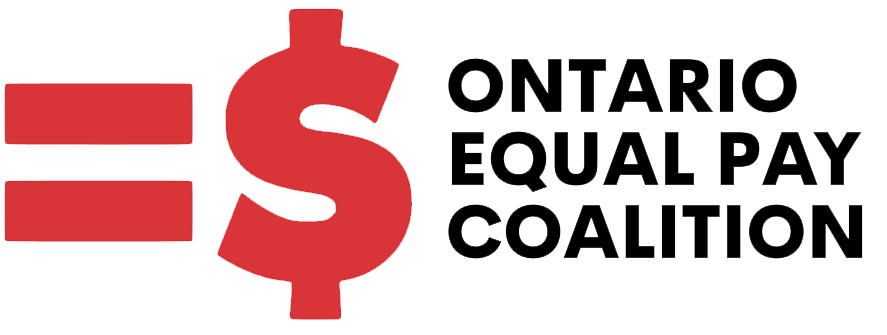Pay Equity Act Enforcement
Support, Strengthen and Revitalize Pay Equity
The Equal Pay Coalition is calling upon the Ontario government to take action to ensure pay equity is achieved and maintained in the province.
The Ontario government must fully fund the Pay Equity Commission so that the Pay Equity Act can be vigilantly enforced.
The Pay Equity Commission is composed of the Pay Equity Office and the Pay Equity Hearings Tribunal. The Coalition is calling for the Commission’s funding to be restored to $6.8 million, the highest level in 1992-93, plus the necessary funding that is required to ensure vigorous enforcement and closing of the pay equity gap.
The Pay Equity Office and the Tribunal have had their funding and staff substantially stripped since the mid-1990s. The Commission has been unable to effectively carry out its extensive enforcement, educational and research duties.
Ontario’s Pay Equity Act is responsible for enforcement of the Act. It investigates, mediates and makes the first level decision in complaints. The Pay Equity Hearings Tribunal adjudicates disputes that arise from those first level decisions. Administrative support for the Tribunal is currently provided by the Ontario Labour Relations Board.
Given widespread non-compliance with the Act, the Coalition is calling on the Office to exercise its pro-active powers contained in section 33(1) of the Act to conduct public education programs; do research, produce papers, provide information and make recommendations to the Minister on enforcement and related matters. There is a great need to ensure that both employers and employees understand their rights and their responsibilities under the Act. Innovative measures all need to be studied and implemented to ensure pay equity is achieved for vulnerable workers, including those disadvantaged by their race, immigrant or Aboriginal status, disability, poverty or lack of union representation.
Pay Equity Commission
The Pay Equity Commission, historically, is under-funded and under-resourced.
In 1992-3, under the New Democratic Party government, the Commission and Tribunal employed 86 people. 28 Review Officers assisted with the proactive enforcement of the Act.
The budget was merely $6.8 million dollars.
By 1997 the budget had been slashed by 46% . Appointments to the Tribunal were cut. Thirteen Review Officer positions were eliminated. The publicly-funded Pay Equity Legal Clinic, which assisted low-income, non-unionized women to enforce their rights, was eliminated.
Between 2003 to 2006, the Liberal government reduced the budget of the Commission, including the Tribunal, by another 20%.
In 2006, there are only 32 employees at the Commission. There are only 16 Review Officers to cover the entire province. There are no regional offices. There is no library service. There is new research or analysis to update the picture of province-wide systemic pay discrimination. There are no educational officers to assist the public or civil service. There is no legal clinic to assist low-income, non-unionized women enforce their rights.
In the fall of 2006, the Pay Equity Commissioner stated, at the Ontario Federation of Labour Pay Equity conference, that the private sector is largely not compliant with their obligations to end pay discrimination; that there are many outstanding enforcement issues in public sector workplaces; and the Commission is working with fewer and limited resources to enforce the Pay Equity Act.
Pay Equity Legal Resources
In the early 1990s, the Ontario Government funded a Pay Equity Legal Clinic to help particularly non-unionized women with legal representation for bringing complaints. This funding was eliminated with the 1995 Government funding cuts. Since then, women have not had any assistance bringing complaints to the Commission. The Coalition is calling for this funding to be restored and increased to address the widespread need for legal assistance.
Pay Equity Decisions
Overview
Below you will find the legislation governing pay equity in Ontario and the leading decisions on issues important to pay equity implementation. For reference to further decisions see the Pay Equity Commission (PEC) site.
The Pay Equity Commission is composed of two separate and distinct bodies; the Pay Equity Office (PEO) and the Pay Equity Hearings Tribunal (PEHT). The Pay Equity Office (PEO) is responsible for implementing and enforcing the Pay Equity Act. The PEO investigates, mediates and resolves complaints under the Pay Equity Act. The PEO also provides programs and services to help people understand and comply with the Pay Equity Act. The Pay Equity Hearings Tribunal (PEHT) is responsible for adjudicating disputes that arise under the Pay Equity Act.
Pay Equity Hearings Tribunal Decisions
Gender Neutral Comparison System
Haldimand Norfolk (No. 6) (1991), 2 P.E.R. 105
Women’s College Hospital (No. 4) (1992), 3 P.E.R. 61
Job Class Comparison System
Barrie Public Library Board (1991), 2 P.E.R. 93
Duty to Bargain
Haldimand Norfolk (No. 6) (1991), 2 P.E.R. 105
Riverdale_Hospital_v._C.U.P.E._Local_79 (No. 1) (1991), 2 P.E.R. 1
Duty to Disclose Information
Cybermedix Health Services Ltd. (1989), 1 P.E.R. 41
Port Hope Hydro (1998), 9 P.E.R. 81
Change in Circumstances
St. Josephs Villa (1993), 4 P.E.R. 33
Niagara No. 2 (1998-99), 9 P.E.R. 25
Duty to Maintain Pay Equity
Ottawa Board of Education (1995), 6 P.E.R. 45
Determining Employer/Employee
Hilton Works (No. 3) (1994), 5 P.E.R. 34
Salvation Army Group of Employers No. 4 (1997), 8 P.E.R. 154
Determining job class
Wentworth County Board of Education (1990), 1 P.E.R. 132
Glengarry Memorial Hospital No. 2 (1992), 3 P.E.R. 34
Determining job rate
Lady Dunn General Hospital (1991), 2 PE.R. 168
York Region Board of Education (Teachers) (N0.4) (1995), 6 P.E.R. 1
Pay Equity Adjustments
Metro Toronto (No. 2) (1995), 6 P.E.R. 79
Gloucester (No. 2) (1991), 2 P.E.R. 208
Pay Equity Settlements and Releases
Bucyrus Blades of Canada v. McKinley (2005), 250 D.L.R. (4 th) 316 (Ont. Div. Ct.)
Better Beef Ltd. v. MacLean (2006), 80 O.R. (3d) 689 (Div. Ct.).
Charter Challenges:
1997 Charter Challenge
Service Employees International Union, Local 204 v. Ontario (Attorney General) (1997), 35 O.R. (3d) 508 (Gen. Div.)
2001 Charter Challenge & 2003 Settlement
- Media Release – April 17, 2001:Women and Unions launch 2nd Charter Challenge
- Court documents submitted by the applicants: Notice of application
- Government Evidence: Affidavit of Gail Ure
- Highlights of Settlement
- Detailed Summary of Settlement
- Memorandum of Settlement – May 2003
Closing the Gap: Real-life examples of wage adjustment
Here are just a few examples of the inequities which were identified after the introduction of the Act and the pay equity adjustments which were won.
- Secondary school secretaries received an annual increase of $7,680 based on their comparison with a male job class of audio-visual technicians.
- Female health technicians were compared to male transportation workers, leading to an increase of $2.79 an hour.
- Female-dominated mental health workers were compared to the male personnel officer’s job, resulting in a pay equity raise of $2.20 per hour.
- Female-dominated police dispatchers were compared to the radio technical supervisors and received an increase of $7,179.00 annually.
- A female job class of law clerk was compared to the male job class of investigator, resulting in a $4.28 per hour adjustment.
- At a baked goods manufacturer, the female job class of personnel manager was compared to the male job class of service manager, resulting in an adjustment of $4.65 per hour.
No other single law in Canada has resulted in such concrete results for so many working women right where it counts – in their pay cheques and benefits. Women who received these adjustments were able to better support themselves, their families and the communities in which they live. Recognizing the value of their work contributed to empowering women and increasing their self-esteem.
Countless studies have shown that society and employers have ignored and undervalued the characteristics associated with women’s work. Equal pay laws which relied on the most vulnerable members of the workforce to complain did not result in any significant progress in reducing the wage gap. Not surprisingly, without a proactive pay equity law, employers are unwilling to voluntarily increase their labour costs to end discrimination. Even with a law, numerous employers in Ontario have tried to ignore or minimize their pay equity obligations.




